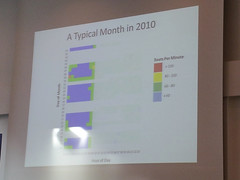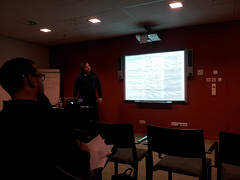Quantified Self 2011
I've just had the pleasure of spending a weekend in Amsterdam listening to an interesting group of measurement-obsessed folks, at Quantified Self 2011. I was introduced to the QS movement a couple of months ago by a chance conversation with Colin Hayhurst, and it piqued my interest. As a former Nike+ user who'd seen the difference personal measurement made to my running habits (tripling the distance I regularly ran) and having participated in Mappiness for a year, I was looking forward to it - and wasn't disappointed.
Some scattered observations and notes, which will do no justice to the event whatsoever:
- Gary Wolf opening the event by showing us footage of a 1930s sleep-tracking machine, with pieces of string attached to a plotter pen and roll of paper. He pointed out that we all understood the "quantified" bit, but the "self" less so;
- Rain Ashford gave an introduction to Arduino and wearable computing. I couldn't help noticing that the sewable stuff she demonstrated tended towards an aesthetic of exposed wiring and circuitry: PCBs look dated to a steampunk degree. The epidermal electronics she showed off from the University of Illinois were fantastic;
- Sascha Pohflepp (who I notice had collaborated with Chris Woebken, one of the folks behind Animal Superpowers, a personal favourite of mine) did a nice breakout session on stories and data tracking - exploring the generation of autobiographies automatically ("auto-auto-biographies") from data captured by phones. "The future of writing will be the future of writing down everything", with the act of recording becoming meaningless as everything is naturally recorded: we're the last generation whose life won't be part of a perfect record. Sascha's been exploring these ideas through a project he called "the book of everything" which sounded like LifeBlog without the blogging: creating a narrative text automatically from on-phone data;

- Kiel Gilleade talked very clearly and entertainingly about lessons he'd learned from a year of gathering his own heart-rate data and streaming it publicly. Some of this covered awareness of health issues (e.g. his resting pulse failing to return to normal levels when sleeping, for a day after heavy drinking); some around data visualisation (time series graphs being rubbish for plotting lots of longitudinal data, coloured coded charts making more sense); and some around the social effects of such data sharing (friends contacting him, concerned to see his heart rate high when he's working hard);
- The team behind iYou showed off some of their visualisations of communications patterns gleaned from their iPhones, looking at how communication moved between SMS, voice and Facebook in different contexts and for different people; at how different media tended to be used for different types of communication (SMS for locative chat, Facebook for messages mentioning love or happiness); and at how different media took precedence at different times of day or night. Autocomplete dictionaries maintained by mobiles are apparently interesting repositories of frequently-used words. One lovely comment which emerged from a group discussion afterwards was the fragility of the notion of "owning one's own identity": it's constructed to a degree by those around you, the idea that you own it just doesn't hold;

- James Burke led an interesting session around quantifying relationships, which took us towards the difficulty of measuring something so completely subjective, rescuing the whole idea of doing so by pointing out that even if such quantifications are devoid of any objective value, they're useful for stimulating helpful conversations;
- Steve Dean did several talks, all of them excellent. One was a history and demonstration of Asmthapolis, a project to track asthma attacks on an individual level by providing inhalers which automatically record their use, generating data which can be useful on an individual level (for combatting subjective views of one's own condition) and societally for mapping asthma attacks and using these maps to inform investigations - as happened in Barcelona in the 1990s, when the unloading of cargo shipments of soya beans were subsequently linked to asthma break-outs. Some of the discussions in these sessions veered a little over my head (third order cybernetic feedback loops? emotional valence?) but Gary Wolf popped up to make a very interesting observation about the tension at the event between those demanding passive data collection (easy, transparent, all-seeing) and those for whom the act of actively recording was itself a source of joy.
That was day one :) Day two followed day one, as it so often does.
- Ian Li gave a nice lightning talk about design considerations for QS products: provide an immediate benefit to the user, respect that their information needs change over time, and help them analyse many types of data as it does so;
- Nancy Dougherty gave a fantastic overview of her experiments with self-made placebo pills to stimulate awareness of, and address, her moods: hacking her own psychology. The pills also contain chips which activate in the stomach and record readings of the inner state of her body, which combined with a patch she wore on her torso gave her a great deal of data to work with. And the whole experiment led to her adopting a mindset of greater control over her emotional state (including 10 minutes of emotional indulgence she noticed she was giving herself, before her placebos kicked in);
- A long and popular session by Maarten den Braber on QS business models raised a few interesting points, notably that many of the participants seemed to presume these models would be based around a Web 2.0-style service. A nice chap from Jawbone quietly gave his perspective on things (which, coming at it from a hardware angle, was a little different), and was clear that they see a market for selling "millions of devices"; and that for many companies this whole area of self-measurement was "the next battleground";
- Steve Dean returned to talk about the practicalities of behaviour change and strategies for achieving it - taking it a little bit beyond rehashing Nudge and towards the work of BJ Fogg - who was referenced several times, and moves a couple of notches up my reading list as a result; apparently quite a few of Fogg's students now work at Facebook, which employs many "hot trigger" techniques to stimulate repeat visits. The important thing seemed to be to provide a path of many individually small steps towards a goal, where intrinsic motivation is possible - rather than trying to continually beat or bribe your audience into behaving how you'd like;
- And finally, Laurie Frick ended the conference showing off her work, consisting mainly of handmade objects derived from self-tracking data - starting from the notion that visual patterns and the rhythms of the brain are somehow connected.
A really interesting couple of days, that's triggered a few ideas I want to follow up and given me a great deal to mull on. The audience was enthusiastic and unashamedly geeky - it all definitely felt excitingly early-stage, though whether in a post-Nike+ world that's accurate is another matter.
I couldn't help but notice that many QS projects rely on after-the-fact analysis of data, and that if you believe that measuring changes what one measures, more immediate feedback would seem to be a useful thing. Context of analysis also popped up again and again - editorialising seeming as relevant and powerful when applied to personal data as to news. And I saw a persistent disconnect between the enthusiasm of the attendees and the number of stories of this stuff going beyond the geeky individual into the mass-market, which is likely the challenge for the field over the coming years. I'm left mulling over how to get this into everyones pockets…
And for your reading pleasure, here's a pile of links which were lovingly thrown out throughout the weekend:
- Zeo sleep tracking;
- Photos from the weekend;
- ManicTime to track your computer usage;
- MoodJam by Ian Li, track your moods using colours;
- BJ Fogg's Behaviour Grid and Behaviour Model;
- InnerTube.me, a tool to aggregate and visualise personal informatics;
- Moodoscope;
- Heart rate monitors from Polar;
- Rapid-I, open source data mining software;
- Boozerlyzer;
Updated: Ian Li has mailed me with links to his design considerations presentation and one he gave on integrating visualisations with Innertube.me.